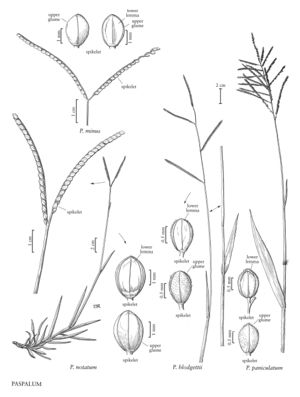Paspalum blodgettii
Plants perennial; cespitose, bulbous; scales pubescent. Culms 40-100 cm, erect; nodes glabrous. Sheaths pubescent or glabrous; ligules 0.2-0.4 mm; blades 5-27 cm long, 1.9-8 mm wide, flat, glabrous, pubescent behind the ligules, margins scabrous, often ciliate basally. Panicles terminal, with 2-6 racemosely arranged branches; branches 1.5-7.5 cm, diverging to spreading; branch axes 0.5-0.8 mm wide, narrowly winged, terminating in a spikelet. Spikelets 1-1.3 mm long, 0.7-0.9 mm wide, paired, appressed to the branch axes, elliptic to elliptic-obovate, glandular pubescent, stramineous to light or golden brown. Lower glumes absent; upper glumes and lower lemmas 3-veined; upper florets 0.8-1.1 mm, stramineous. Caryopses 0.9-1.1 mm in diameter, orbicular, amber. 2n = 40.
Distribution
Puerto Rico, Fla.
Discussion
Paspalum blodgettii grows in hammocks, low pinelands, and along roadsides in southern peninsular Florida, the Bahamas, the Greater Antilles, southeastern Mexico, and Belize.
Selected References
None.
